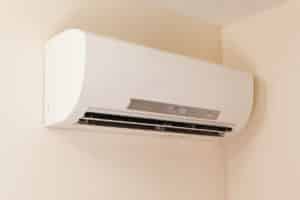
If you are considering getting air conditioning, it probably hasn’t taken you long to realize that there are many different types of AC units. One of the types you have probably come across is “ductless air conditioning.” It’s vital to understand this term to make a decision about what is the best type of air conditioning for you.
Ductless air conditioning is, in the broadest sense, any type of air conditioning that doesn’t use ducts to carry cool air through a house or building.
In ductless air conditioning, air is cooled close to where it is needed. Typically, this is in the room that is to be cooled. It is distributed a short distance by relatively low-powered blowers.
 Ductless air conditioning is distinguished from central air conditioning. In central air conditioning, air is cooled at a central location, then pushed by a blower via ducts to the rooms to be cooled.
Ductless air conditioning is distinguished from central air conditioning. In central air conditioning, air is cooled at a central location, then pushed by a blower via ducts to the rooms to be cooled.
However, it’s important to understand that there are three types of ductless air conditioning in common use:
These units share the same basic characteristic of not using ducts, but they can have very different operating and installation elements.
Portable air conditioning units are designed to be carried around and used to cool air in locations where there is no installed air conditioning. This might include certain indoor spaces and outdoor spaces.
Window air conditioning units are designed to be installed in windows or sometimes locations with a very thin partition between the two parts of the air conditioner.
Split air conditioning units are separated into two parts. One part is installed inside the space to be air conditioned. The other part is installed outside the building, separated from the other unit by a wall or an added heavily insulated barrier. The two segments are connected by copper tubing that allows refrigerant to pass between them but prevents other heat transfer between the separated parts.
 One of the potential benefits of ductless air conditioning is that it can be very efficient at cooling. That’s because the cooled air is produced close to where it is needed. When cool air passes through ducts, it becomes heated, reducing the efficiency of the central air conditioning system.
One of the potential benefits of ductless air conditioning is that it can be very efficient at cooling. That’s because the cooled air is produced close to where it is needed. When cool air passes through ducts, it becomes heated, reducing the efficiency of the central air conditioning system.
Another source of efficiency is that ductless air conditioning allows for each cooled space to be cooled independently. This means that cooling is often used only where it’s needed, with unused rooms closed up and allowed to warm when not in use. It also lets people select their own cooling preference, so you don’t have a situation where one person cools the house so much that others resort to blankets or sweaters to keep warm. Instead, the person who prefers a very cold room can keep their room cold, while others can spend time in warmer rooms.
Ductless air conditioning can also cost less to install in situations where there are no ducts or the ducts are inadequate to move cool air.
On the other hand, some ductless air conditioning can be very inefficient. That’s because the hot part and the cold part of the air conditioning system may not be well separated. With a portable air conditioning unit, there is essentially no separation between the hot and cold regions. The air conditioner ends up heating the air it is taking in to be cooled.
A window air conditioner is a little better. It separates the hot side of the system and the cold side with the windowpane. This reduces the amount of waste heat that enters the cooled area, but doesn’t completely stop it. If you use a window air conditioning unit, you should feel the window around the air conditioner and compare it to another window in the same room—it will likely be hotter.
A split air conditioning unit doesn’t have this problem since it separates the two parts of the system adequately with an insulating barrier.
However, all ductless air conditioner units share one inefficiency: they must be installed in every room where you want cooling. This can make installation costs very high for this type of air conditioning. However, it might still be less expensive than adding new ducts to some older constructions.
In some ways, Portacool portable evaporative coolers are like a kind of ductless air conditioning system. That’s because they produce cool air right where the air is needed. However, there are several important differences between the two.
First, unlike air conditioning units, a Portacool doesn’t create a lot of waste heat. This means there’s no inefficiency from using a Portacool outdoors or in a large room full of hot air. In fact, any heat in the air actually helps a Portacool to function properly. It uses the ambient heat to evaporate water, which cools the air.
Second, a Portacool is designed to put out a lot more cool air than ductless air conditioning units. For example, a window AC unit might blow only a few hundred cubic feet per minute (CFM) of cool air, while a Portacool may blow tens of thousands. This helps cool a space more quickly and allows a Portacool to effectively cool areas where it’s impossible to trap cooled air, such as outdoors.
For any situation where you might be considering a portable air conditioner, a Portacool is likely a better option, provided you have access to an outside air source. Any time you are considering a ductless air conditioning system, you should also consider whether a Portacool would more effectively address your needs.
If you have access to outdoor air (a requirement for evaporative coolers to deliver optimal performance), a Portacool will most likely be the ideal solution for your needs. However, if you’re strictly looking to cool enclosed spaces, one of these ductless air conditioning solutions may prove to be more effective.
To purchase a Portacool, please visit a local or online retailer. For detailed questions or to make a bulk order, please use our online contact form.